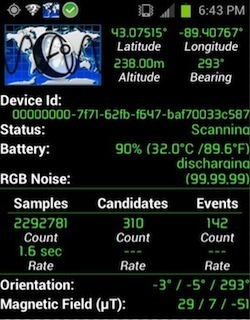Physicist turns smartphones into pocket cosmic ray detectors

Justin Vandenbroucke, an assistant professor of physics, holds a pair of smartphones in Chamberlin Hall. Vandenbroucke has created a pocket cosmic ray detector app, DECO, which uses the image sensor of a cellphone camera.
Soon, the growing capability of your smartphone could be harnessed to detect cosmic rays in much the same way as high-end, multimillion-dollar observatories.
With a simple app addition, Android phones, and likely other smartphone brands in the not-too-distant future, can be turned into detectors to capture the light particles created when cosmic rays crash into Earth’s atmosphere.
“The apps basically transform the phone into a high-energy particle detector,” explains Justin Vandenbroucke, a University of Wisconsin–Madison assistant professor of physics and a researcher at the Wisconsin IceCube Particle Astrophysics Center (WIPAC). “It uses the same principles as these very large experiments.”
Cosmic rays are energetic subatomic particles created, scientists think, in cosmic accelerators like black holes and exploding stars. When the particles crash into the Earth’s atmosphere, they create showers of secondary particles called muons.

A screen capture of the DECO app in action displays data, including the number of cosmic events recorded.
Photo: Justin Vandenbroucke
Smartphone cameras use silicon chips that work through what is called the photoelectric effect, in which particles of light, or photons, hit a silicon surface and release an electric charge. The same is true for muons. When a muon strikes the semiconductor that underpins a smartphone camera, it liberates an electric charge and creates a signature in pixels that can be logged, stored and analyzed.
Cosmic rays emanate from beyond our solar system and are constantly bombarding our planet. Their origins continue to confound astrophysicists as the high-energy particles that compose cosmic rays travel vast distances and their trajectories are bent as they traverse the magnetic fields that abound in interstellar space. Cosmic rays are commonplace and frequently confound astronomical observations looking for other phenomena.
The idea behind the pocket cosmic ray detector is primarily educational, notes Vandenbroucke, who embarked on the project as a graduate student at the University of California, Berkeley, at the suggestion of classmate Kenny Jensen, who wrote an early version of the app that powers the smartphone cosmic ray detector.
The project, known as DECO for Distributed Electronic Cosmic-ray Observatory, is supported by grants from the American Physical Society as well as the Knight Foundation and the Simon-Strauss Foundation. It was abetted this past semester and summer through the programming skills of recent Janesville Craig High School graduate and WIPAC intern Matthew Plewa.
“I’d been working in the Android ecosystem for a while and it was just one of those hobbies that happened to work out,” says Plewa, who plans to study engineering at Iowa State University.
To help transform DECO into a potent educational presence, Vandenbroucke’s WIPAC group — with grant support from QuarkNet, a national program in particle physics and teacher professional development — plans to engage high school teachers to develop curricular materials around the use of the smartphone cosmic ray detector.
To turn your phone into a cosmic ray detector, Vandenbroucke explains, you need to download the app and cover the phone’s camera lens with duct tape. The phone can then be placed screen up just about anywhere, even in a desk drawer as muons can penetrate matter much like X-rays. (Muon detectors are used, for example, to sketch out hidden geological features and even buried structures of archaeological interest.)
“It would be great to get students and the public interested in gathering data and understanding the particles around them, things they ordinarily don’t get a chance to see.”
Justin Vandenbroucke
Left running, an idle phone can be set to record images, which are then analyzed to search for particle events. DECO works by taking an image every couple of seconds. The DECO app analyzes the image and if enough pixels light up, it gets recorded as an event. Particle tracks from both cosmic rays and radioactivity in the environment can be recorded.
Events may sometimes be matched to cosmic phenomena detected by other, more sophisticated observatories and experiments. The DECO app platform also includes a data logger app that routes event information — time, location and observations — to a central database.
Vandenbroucke validated the smartphone cosmic ray detector by setting it up and logging data on long-distance commercial airline flights. Muons are more easily detectable at high altitudes, so the Wisconsin physicist would plug in the detector and switch it on once the flight reached cruising altitude.
Pocket cosmic ray detectors are unlikely to overtake the large, sophisticated detectors astrophysicists use, but if enough people put idle or old cellphones to use to capture muons, the project initiated by Vandenbroucke could one day evolve into a meaningful “citizen science” project.
“It would be great to get students and the public interested in gathering data and understanding the particles around them, things they ordinarily don’t get a chance to see,” says Vandenbroucke.




